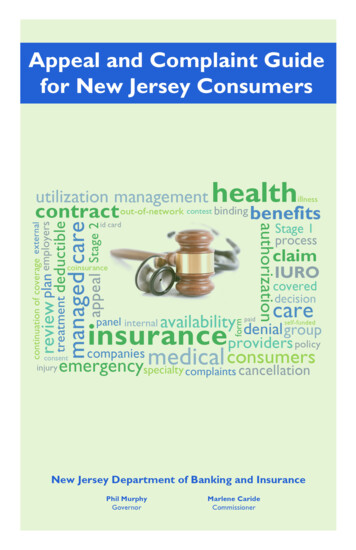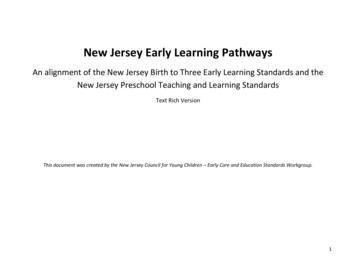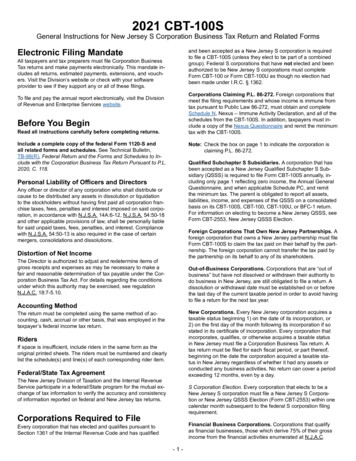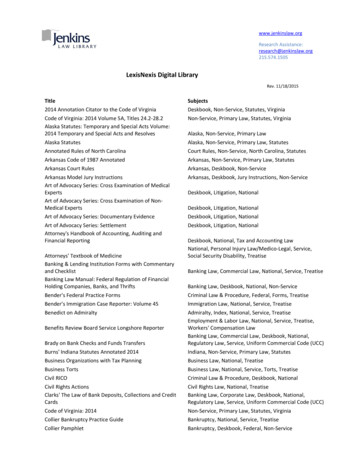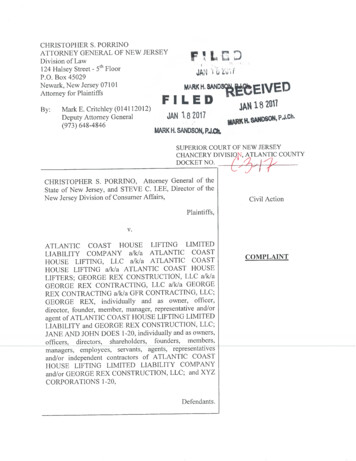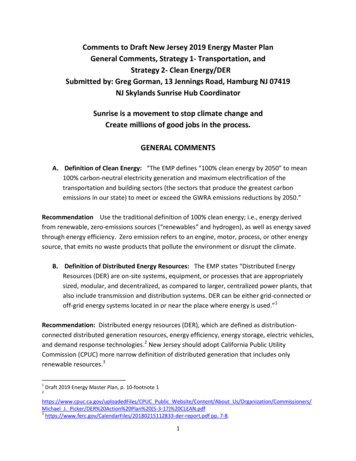
Transcription
Comments to Draft New Jersey 2019 Energy Master PlanGeneral Comments, Strategy 1- Transportation, andStrategy 2- Clean Energy/DERSubmitted by: Greg Gorman, 13 Jennings Road, Hamburg NJ 07419NJ Skylands Sunrise Hub CoordinatorSunrise is a movement to stop climate change andCreate millions of good jobs in the process.GENERAL COMMENTSA. Definition of Clean Energy: “The EMP defines “100% clean energy by 2050” to mean100% carbon-neutral electricity generation and maximum electrification of thetransportation and building sectors (the sectors that produce the greatest carbonemissions in our state) to meet or exceed the GWRA emissions reductions by 2050.”Recommendation Use the traditional definition of 100% clean energy; i.e., energy derivedfrom renewable, zero-emissions sources (“renewables” and hydrogen), as well as energy savedthrough energy efficiency. Zero emission refers to an engine, motor, process, or other energysource, that emits no waste products that pollute the environment or disrupt the climate.B. Definition of Distributed Energy Resources: The EMP states “Distributed EnergyResources (DER) are on-site systems, equipment, or processes that are appropriatelysized, modular, and decentralized, as compared to larger, centralized power plants, thatalso include transmission and distribution systems. DER can be either grid-connected oroff-grid energy systems located in or near the place where energy is used.” 1Recommendation: Distributed energy resources (DER), which are defined as distributionconnected distributed generation resources, energy efficiency, energy storage, electric vehicles,and demand response technologies.2 New Jersey should adopt California Public UtilityCommission (CPUC) more narrow definition of distributed generation that includes onlyrenewable resources.312Draft 2019 Energy Master Plan, p. 10-footnote 1https://www.cpuc.ca.gov/uploadedFiles/CPUC Public Website/Content/About Us/Organization/Commissioners/Michael J. der-report.pdf pp. 7-8.1
C. Least-cost vs. highest net value: Goal 2.1.3 is “Model scenarios and pathways toachieve 100% clean, carbon-neutral electricity generation by 2050 with considerationfor least-cost options.”Recommendation: The Clean Energy Economy and technology opens a vast opportunity forimproving our environment, society, and economic growth. It should be treated as aninvestment in the future. The Rutgers NJ Energy Storage Analysis noted that battery storageapplications that do not yet yield positive returns for investors have social benefits to includeincreasing hosting capacity for decentralized solar photovoltaics (PV) and increasing resiliencein combination with solar PV. Electric buses significantly reduce pollution levels and improvestudent academic performance. Goal 2.1.3 should read “Model scenarios and pathways toachieve 100% clean, carbon-neutral electricity generation by 2050 with consideration forhighest net value options.” This will allow integrative planning to consider environmental,social, and economic costs/benefits to assess alternatives and select the best path forward.D. Basic Planning Principles: In simple terms, a plan consists of three elements: adescription of the current position (baseline), a description of future (goal), and the pathto reach the goal. Draft NJ 2017 Energy Master Plan’s scope encompasses energydemand and greenhouse gas reductions for transportation, residential, commercial, andindustrial purposes. The document describes a number of actions planned or beingimplemented, but neither the baseline nor the goal defined in terms necessary to gagethe effectiveness of policy and actions. A common measure allows easy comparison.For instance, Offshore-Wind goal is defined as MW (a measure of capacity) whereas thegoal of 100% Clean Energy is measured in MW hours (consumption). How many MW’sof solar, wind, and energy storage are needed to meet 2050 MWh demand?Recommendation: Describe the energy baseline using data the available and acceptable.The U.S. Energy Information Agency publishes an annual Energy Profile describingconsumption by source, fuel, electric generation, and prices. 4 The annual BTU baselinedata can be converted to GW or MW hrs. and used to project future values or goals basedon energy efficiency and economic growth assumptions. This measure allow assessmentof planned events such as closure of nuclear plants, the need for Natural gas projects, andthe effectiveness of policy to achieve energy master plan objectives. This consumptionmeasure (MWh) facilitates calculation of Green House Gas emissions. Here is a sample ofthe EIA Data for 2017 by End-use sector and fuel:4https://www.eia.gov/state/?sid NJ#tabs-52
New Jersey Energy Consumption by End-Use Sector 2017Source: Energy Information AdministrationState Energy Data SystemCategory Energy Consumption by End-Use SectorNew Jersey Energy Consumption Estimates Trillion nsportation 782.5Total2134.8New Jersey Energy Consumption byFuel Estimates 2017CategoryCoalNatural GasMotor Gasoline excl. EthanolDistillate Fuel OilJet FuelHGLResidual FuelOther PetroleumNuclear Electric PowerHydroelectric PowerBiomassOther RenewablesNet Electricity ImportsNet Interstate Flow of ElectricityNew Jersey Energy Consumption Estimates .90.156.126.3038.52134.83
Strategy 1: Reduce Energy Consumption andEmissions from the Transportation Sector:1) In considering the policy mechanisms suggested in Strategy 1, how should the state seek toimplement the policies to reduce transportation-related emissions? What policy mechanismshave we missed?Response: “To maximize CO2 reduction and effectively, electrification of the transportationsector early focus should be placed on heavy duty vehicles and charge stations”. For every1,000 EV buses, the global demand for fuel drops by about 500 barrels a day.5 Similar impactresults from removing mid-sized and heavy duty diesel trucks. Range and charging are biggerissues for trucks than cars. (Let industry solve the range problem.) Planning and deployment ofcharge stations along high traffic routes to service these vehicles must also consider light dutyvehicles, emergency evacuation demands, and critical facilities. Electric storage paired withbidirectional chargers to facilitate Vehicle to Grid should be mandated. Focus on buses andheavy duty vehicles will directly benefit EJ communities by reducing pollutants and encouragemass transit.Children are especially susceptible to the adverse health effects of diesel exhaustpollutants.6 There is no established safe level of exposure for school age children. An emphasis7Priority on replacing school buses provides ensures the wellbeing of children and providesenvironmental/cost benefits and potential property tax relief.Federal Policy and commercial market for light duty passenger EVs will be drivingdemand for the next 5-10 years. Considering the NJ is a “crossroads” state with a highpercentage of interstate drivers and transport, investment focus on charge stations versusvehicle incentives is recommended. To capitalize on commerce trends of the future, NJ mustcreate an environment to allow the proliferation of EVs.Recommendation: In addition to electrifying all rail lines, New Jersey should restore all trainservice cut since 2006 and improve frequency of service like Metro North with off-peak 20minute service or better. (The Regional Plan Association actually called for 10 minute Railservice in NJ urban core and 15 or 20 minute frequencies just outside the urban ication/24422246 School bus pollution and changes in the air quality atschools A case -cleaner-air pp8-94
Recommendation: In regards to frequent service on train lines and bus lines. NJ Transit shouldbe tasked with defining and implementing a frequent service public transit network (includingnon-NJT operators) by July 2020 and begin implementing by July 2021; such that 70% of thestate's population is within 1/2 mile of a bus or rail stop with frequent service by 2026.Recommendation: Establish funding mechanism for the acquisition of electric-poweredpublicly used vehicles (school buses, transit buses, trucks, vans, and cars) This "electric vehicletransition fund" would provide state loans to municipal, county, state, schools, and privatelyowned companies providing public transportation services. Loans would be repaid fromoperating savings.Recommendation: Beyond electrification of the transit fleet, there are a number of things thatcan be done to make public transit more attractive and to induce people out of their cars. Thisfall into two categories:a. Access and wait –1. Add shelters with heat and real time info. to all bus and rail stops with at least 200boardings per day (as a starter)2. Ensure good bus and train stop access via bike paths, sidewalks, and crosswalks.3. Ensure good lighting at and near transit stopsb. The trip - Use a number of low-cost strategies to speed the bus trip, especially in peakhours. These include:1. Reducing stops, where closely spaced2. Creating bus only lanes in congested traffic areas, especially in peak periods3. Bus preferential treatment at traffic signals, such as leading greens or extended greensdepending on the situationc. Provide better ways to access public transit info. (One part of our grant from National willaddress the NJT website in this respect.)2) The state seeks to “lead by example” in the electrification of its fleet. What case studies,cities, states, etc. should New Jersey look to and learn from as it rolls out clean light-dutyvehicles and buses?Response: The World Resources Institute issued three reports based on evaluation ofexperiences with Electric bus it-buses-tool5
Response: “Air Quality Strategies and Technologies: A Rapid Review of the InternationalEvidence” May 2019 provides a summary of actions focusing on ation/333099345 Air Quality Strategies and Technologies A Rapid Review of the International Evidence3) Over what timeline should the state seek to rollover its light-duty (passenger) fleet to EV?Over what timeline should the state rollover its bus fleet? Please also consider incrementalmilestones.Response: It took eight years for Shenzhen, China to become the first city to electrify 100percent of its public buses—16,359, to be exact.8 NJ should be able to rollover its light-dutyand bus fleet in five years.4) How can the state work with the private sector to increase publicly-accessible EV charginginfrastructureResponse: Provide tax incentives to combine PV solar, behind the grid Electric Storage, and bidirectional chargers to industry and commercial users. As suggested by the Electric StorageAnalysis, electric storage with solar maximizes grid utility provides business revenueopportunity for arbitrage and demand response. Adding bi-directional chargers enablesemployees and public an opportunity to capitalize on this opportunity. This would alsoencourage private EV sales. Combine this with low interest loans if appropriate.5) How can the state work with the private sector to advance the technology for mediumand heavy-duty vehicles and incentivize private sector adoption of alternative fuel vehicles?Response: Suggest review of “Working Paper: Financing Low- and Zero- emission FreightTransportation Technologies in California A review of Funding Sources and StackingOpportunities” August 2018.9 This is a report issued by the Goldman School of Public Policy.The report provides a roadmap to California programs designed to boost markets for electrictrucks, freight equipment and supporting infrastructure.6) What policy mechanisms should the state develop to reduce greenhouse gas emissions atits unding Programs Summary final August 29.pdf6
Response: Suggest you review Port of Oakland Maritime Air Quality Improvement Plan10. “AirQuality Strategies and Technologies: A Rapid Review of the International Evidence” May 2019provides a summary of other actions focusing on transportation.11 The strategies andtechnologies described can also be applied to ships, equipment, and vehicles unique to theport.Strategy 2: Accelerate Deployment of Renewable EnergyAnd Distributed Energy Resources:7) New Jersey is currently targeting the installation of 3,500 MW of offshore wind generationby 2030, but there is likely room for much more growth. Can New Jersey achieve more? Whyor why not, and if so, how much is feasible? What concerns and barriers must we address indeveloping this resource?Response: The offshore wind resource potential based on analysis of wind speed interval of 7mph or greater within 50 nm of shore is 99,675 MW.12 “U.S. DOE estimates that the existingand proposed federal lease areas located off the coast of New Jersey could support up to 12.5GW of offshore wind energy, using a very conservative power density ratio. Using a moreaccepted power density ratio could double the amount of offshore wind that could besupported in these lease areas.”13 In terms of potential capacity, there is no barrier; instead, NJhas an opportunity to become energy independent.A recent article in Forbes reported “According to a recent study released by GlobalIndustry Analysis, offshore wind capacity is forecast to grow by over 80 gigawatts (GW) through2024, achieving an impressive Compound Annual Growth Rate (CAGR) of more than 25% in thatperiod.” The article also noted that “According to projections from the InternationalRenewable Energy Agency (IRENA), global growth in offshore wind energy will continue toaccelerate, with total installed capacity rising from 19.2 GW in 2017 to 520 GW in 2050.” “TheUnited States – one of the world’s most prominent wind energy producers – has around 2 GWof offshore wind but could achieve over 20 GW by 2030 under favorable market and regulatoryconditions. America’s offshore wind potential is estimated to be greater than 22,000 GW (or 22Terawatts), double the country’s current electricity consumption.”14 The projected rapidgrowth of offshore wind indicates that may of the supply and logistic issues appear to mentplan/11Sustainability 2019, 11(10), 2757; change.energy.gov/files/pdfs/offshore/offshore wind potential table.pdf13Draft NJ 2019 EMP, p. te-foroffshore-wind/#f10510165e7c7
been resolved. In terms of market availability, there is no barrier; instead, NJ has anopportunity to benefit from anticipated lower costs and improved products.The support labor and infrastructure developed to support the Orsted award of1100MW in June 2019 with all turbines up and spinning by 2024 lays a foundation to acceleratedeployment of offshore wind. NJ plan to solicit an additional 1200MW in 2020 and 2022ignores the learning curve principle that a person’s performance improves as one gainsexperience. Instead of leveling off, the schedule should ramp up. NJ must maximize thisadvantage to dominate the offshore wind niche and become a net energy exporter.Recommendation: The offshore wind goal for 2030 should be 9.6 GW or greater to replacefossil fuel and nuclear generated electricity. An alternative goal for 2030 is 12 GW or greater toutilize all the available capacity offered by the Federal lease. NJ would then be a net exporterof electric power. The suggested solicitation schedule for the additional 8.5 GW is: Solicit 2,100megawatt OREC 2020 with Commercial Operation Date (COD) 2024. Solicit 2,400 megawattOREC 2020 with Commercial Operation Date (COD) 2028. Solicit 4,000 megawatt OREC 2020with Commercial Operation Date (COD) 2030.Recommendation: If offshore wind is to be successful, electric storage capability is a necessaryprerequisite. Wither it is behind or in front of the meter, wind generated electrical powerneeds storage to maintain a balanced grid and reliability standards. The Electric StorageAnalysis focuses on opportunities within the State of New Jersey. Suggest that, especially forgrid storage, consideration of out of State solutions be considered also. Think out of the boxand seek energy storage solutions that have ancillary benefits. For example, LakeHopatcong, Greenwood Lake, Round Valley, Spruce Run, and other venues could be used forpumped hydro electrical storage. They could be grid scale such as Yards Creak or micro hydroscale. Either way, revenues and operation could be used to maintain safe nutrient levels.Screens protecting water intake pipes can function to capture and remove excess vegetation.Another suggestion is to integrate “power walls” in stadiums, arenas, and similar venues. Thesesystems can be integrated into micro grids to improve resiliency and emergency power forcritical service providers.8) How should New Jersey address the solar and NJ Class I cost cap established in the CleanEnergy Act? No response.9) Does the allowance in the current RPS on the use of unbundled Renewable EnergyCertificates (RECs) interfere with state efforts to incentivize in-state renewable energy powergeneration? No response.8
10) Which policy mechanisms do you recommend the state implement to lower the cost ofcapital for in-state renewable energy power generation?Response: Adopting New York States “Value Stacking” is suggested to provide investors a clearunderstanding of the value of solar and lower risk. The net result would be lower cost ofcapital.1511) What policy, legislative, or regulatory mechanisms can New Jersey develop to ensure thatit can most cost-effectively pursue a 100% carbon neutral power sector?Response:1. Impose a “Ban on Fossil Fuel Projects” until the legislature, BPU and DEP develop rulesand procedures and any laws needed to reg ulate GHG’s in New Jersey, and adoptspecific annual plans to reduce GHG’s consistent with Executive Order 28, the State’scommitments in the Global Warming Response Act and the US Climate Alliance. 162. NJ Pension Funds divest from fossil fuel companies and “dirty banks.173. Incentivize Energy Storage for industrial and commercial users. Incentive programshould encourage pairing with PV Solar and bidirectional EV charge stations. (Rutgers NJEnergy Storage describes benefits ranging from peak load reductions, demand response,and other benefits. Energy storage enables businesses to turn off grid connectionduring peak electricity demand periods and continue operation.) Massachusetts EnergyStorage Study18 estimates 600 MW of advanced energy storage captures 800 million insystem benefits.4. Micro grid development remains a customization design process which leads to delaysand expenses throughout the permitting, construction, and testing processes.Recommend that NJ focus on planning rather than execution until industry standardizesproducts and PJM finalizes rules for micro grids. Be an early adapter instead of adeveloper.5. NJ’s Town Center Distributed Energy Resource Microgrid Program focuses on resiliency.Future DER Microgrid initiatives need to also address reliability improvement andefficiency. National Conference of State Legislator’s “State Efforts to Protect theElectric Grid” April 201619 provides a summary of what other states have /2018/06/Banking on Climate ocuments/energy/ENERGY SECURITY REPORT FINAL April2016.pdf9
Comments to Draft New Jersey 2019 Energy Master Plan General Comments, Strategy 1- Transportation, and Strategy 2- Clean Energy/DER Submitted by: Greg Gorman, 13 Jennings Road, Hamburg NJ 07419 NJ Skylands Sunrise Hub Coordinator Sunrise is a movement to stop climate change and Create millions of good jobs in the process. GENERAL COMMENTS


